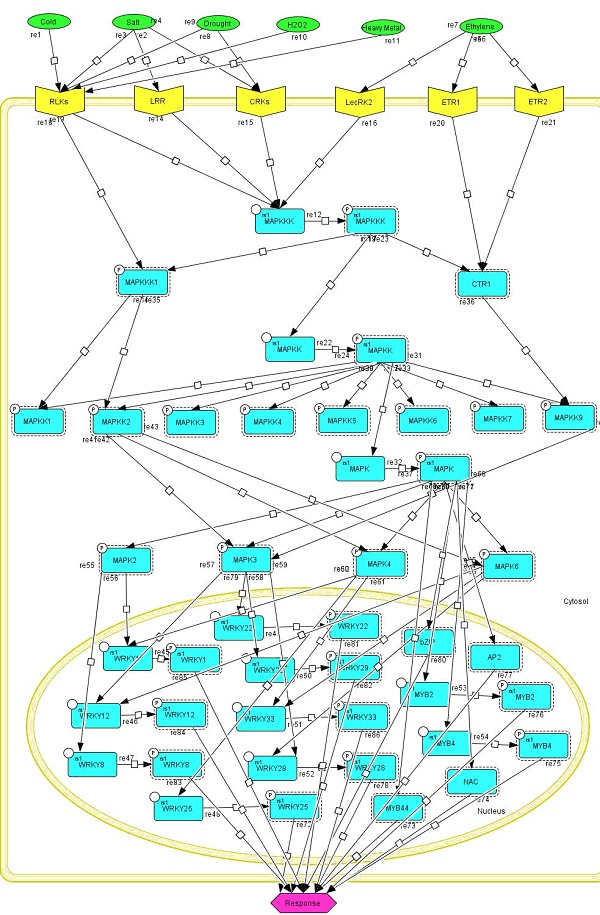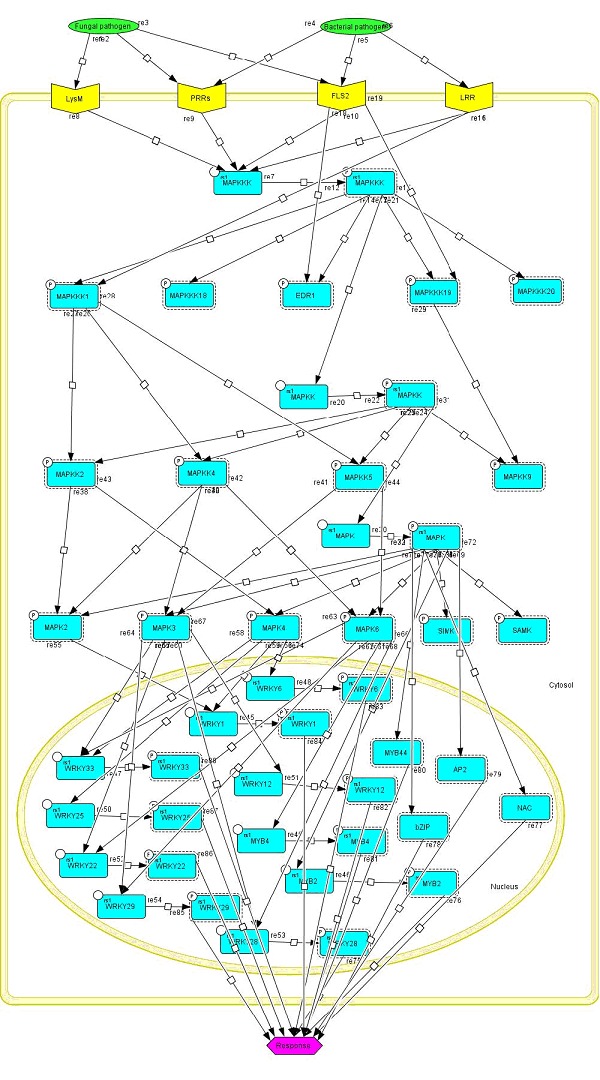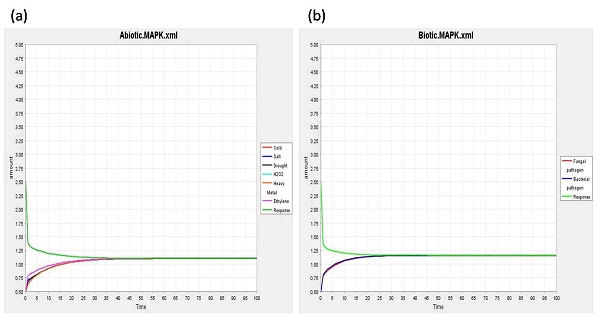Abstract
Mitogen-Activated Protein Kinases (MAPKs) cascade plays an important role in regulating plant growth and development, generating cellular responses to the extracellular stimuli. MAPKs cascade mainly consist of three sub-families i.e. mitogen-activated protein kinase kinase kinase (MAPKKK), mitogen-activated protein kinase kinase (MAPKK) and mitogen activated protein kinase (MAPK), several cascades of which are activated by various abiotic and biotic stresses. In this work we have modeled the holistic molecular mechanisms essential to MAPKs activation in response to several abiotic and biotic stresses through a system biology approach and performed its simulation studies. As extent of abiotic and biotic stresses goes on increasing, the process of cell division, cell growth and cell differentiation slow down in time dependent manner. The models developed depict the combinatorial and multicomponent signaling triggered in response to several abiotic and biotic factors. These models can be used to predict behavior of cells in event of various stresses depending on their time and exposure through activation of complex signaling cascades.
Keywords: MAPKs, Modeling, Simulation, Abiotic, Biotic, CellDesigner, SBMLsqueezer, System Biology
Background
MAPK cascades are conserved signaling modules found in all eukaryotic cells including plant, fungi and animals. A mitogenactivated protein kinase cascade minimally consists of three kinases such as MAPKKK, MAPKK and MAPK. The MAPK cascades play important role in intra-cellular and extra-cellular signaling in plants [1]. They play a essential roles in transduction of diverse extra- cellular stimuli such as biotic and abiotic stresses as well as a range of developmental responses including differentiation, proliferation and death. Several cascades are induced by different biotic and abiotic stresses stimuli such as pathogen infections, heavy metal, wounding, high and low temperature, high salinity, UV radiation, Ozone reactive oxygen species, drought and high or low osmolarity. MAPKs regulate a diverse set of processes, including abscission, stomatal and ovule development, signals for various abiotic stresses, and defense responses against bacterial and fungal pathogens [2, 3]. Environmental stresses, such as cold, drought, salinity and heavy metals are important factors that affect growth and metabolism of plants. Several MAPK cascades are induced by different stresses and mediate signal transduction from cell surface to the nucleus [4]. Plant responds to pathogen attack by activating multi-step defense responses, including rapid production of reactive oxygen species (ROS), strengthening of cell walls and induction of hypersensitive response leading to localized cell death at the sites of infection. Plant defense responses also include synthesis of pathogenrelated protein and phytoalexins [4, 5]. It has been firmly established that MAPKs play a central role in pathogen defense in Arabidopsis, Tobacco, Tomato, Parsley, Brassica and Rice.
Crystallographic studies demonstrate that approximately all members of MAPK family share similar three dimensional structures and function that are highly conserved. It functions by protein-protein interaction and post translational modification. MAPK showing protein-protein interaction to different type of transcription factor such as WRKY, MYB, and MYB related, NAC, AP-2 and bZIP etc. In earlier study at our lab, we selected only six major transcription factor such as WRKY, MYB, MYB related, NAC, AP-2 and bZIP because literature survey shows that these transcription factor showing protein-protein interaction to MAPK and bind to specific promoter sequence and play a regulatory role in plant defense mechanisms. Plants grown in the natural environment are continually exposed to a variety of potential pathogens without becoming diseased. This is because plants can identify and react to pathogenic organisms and activate multiple defenses, including the production of diverse antimicrobial metabolites and protein [6].
WRKY genes act as an important transcription factors superfamily and they involved in response to environmental stimuli, such as high salt, drought, heat, cool and other abiotic stresses. They participate in plant growth and development and material metabolic pathways, and also play an important regulatory role in anti-viral, anti-bacterial and mechanical injury pathways, showing that WRKY transcription factor have a complex and important role in regulation [7]. Transcriptional regulation of defense gene expression is a crucial part of plant defense environment stresses. As one of the largest plant transcription factor families, MYB transcription factors play an important role in plant stress tolerance [8]. Protein encoded by the NAC gene family constitute one of the largest plant-specific transcription factors, which have been identified to play many important role in both abiotic and biotic stress adaptations as well as plant development regulation [9]. Transcription factors of basic leucine zipper (bZIP) family control important process in all eukaryotes. In plants, bZIPs are regulators of many central developmental and physiological processes including photomarphogenesis, energy homeostasis, and abiotic and biotic stress responses [10]. In order to understand the multistep signaling in such intricate process, there is a need of modeling through computational tools. In the present study attempts have been made to dissect the complex MAPK cascades initiated in response to different stimuli through system biology approach that shows the behavior of a single plant cell, using modeling and simulation study.
Methodology
Construction of the MAPK activation Model:
Literature studies follow us to determine the relationships between the species in the model Table 1 & Table 2 (see supplementary material). The network of MAPKs signaling pathway was created using CellDesigner 4.1 (http://www.celldesigner.org/), software that enables user to describe molecular interactions using a well defined and consistent graphical notation [11, 12].
Simulation data:
In the present study, real concentration was not used as there were no experimental investigations that reported quantitative data for a single cell. In absence of quantitative data of a single cell, it is not possible to define a concentration; that refer in term of amount. We set every species in model equal to a unit of amount, the value ranged 0.5 to 2.5. The amount of different types of abiotic and biotic stresses was set equal to 0.5, amount of receptors was set equal to 0.8, amounts of MAPK family (MAPKKK, MAPKK and MAPK) was set equal to 1, amount of transcription factor WRKY was set equal to 1.2, MYB 1.5, NAC 1.8, bzip 2, AP-2 2.2 and response was set equal to 2.5 as amount. The data of molecular interaction are stored in System Biology Markup Language (SBML; http://www.sbml.org/). SBML is a standard machine readable model representation format [13].
Model Kinetics:
The software SBMLsqueezer was used to generate kinetic rate equations for our model. In which the kinetic equations have to be associated with each reaction. This approach facilitates the modeling step via automated generation of equation. The software SBMLsqueezer offers different type of kinetics (i.e. mass action, Hill, and several Michaelis-Menten based kinetics) each including activation, inhibition and reversibility or irreversibility for representing signaling pathways and networks [14]. SBMLsqueezer generates the kinetic equation for our model, which was then simulating in CellDesigner ver4.1.
Results
Description of model:
Model of the MAPK machinery activation in response to various abiotic and biotic stresses in plants was created to simulate MAPK signaling pathway for better understanding. The Abiotic model (Figure 1) showing the action of abiotic stresses such as cold, salt, Drought, H2O2, Heavy metal, Ethylene on different types of receptors in cell surface and activation of MAPK members in cytosol with downstream transcription factors in nucleus, then showing the response using phenotype symbol of System Biology Graphical Notation (SBGN) in CellDesigner. Biotic model (Figure 2) showing the action of biotic stresses such as bacterial pathogen and fungal pathogen on MAPK machinery with upstream receptors and downstream transcription factors, then showing the response using phenotype symbol of SBGN in CellDesigner.
Figure 1.

MAPK abiotic activation model was created using CellDesigner ver.4.1. The graphical representation is compliant with system biology graphical notation (SBGN), Process diagrams, explicitly displaying simple molecules like abiotic stresses (Cold, Salt, Drought, H2O2, Heavy metal, Ethylene), receptors, proteins (different members of MAPKs with transcription factors) some of phosphorylated forms. The active state of the molecules is indicated by a dashed line surrounding the molecule and response in the form of phenotype symbol by using different form of colors and shape for some species, the frame in yellow represents the cellular membrane.
Figure 2.

MAPK biotic activation model was created using CellDesigner ver.4.1. The graphical representation is compliant with system biology graphical notation (SBGN), Process diagrams, explicitly displaying simple molecules like biotic stresses (Fungal pathogens, Bacterial pathogens), receptors, proteins (different members of MAPKs with transcription factors) some of phosphorylated forms. The active state of the molecules is indicated by a dashed line surrounding the molecule and response in the form of phenotype by using different form of colors and shape for some species, the frame in yellow represents the cellular membrane.
Model simulations:
Simulation can help us to understand the internal nature and dynamics of biological processes and to arrive at well funded prediction about their future development. Simulation results of abiotic and biotic stress activation model shows that, when the intensity of abiotic and biotic stresses were increases at this time the responses like cell division, cell growth and cell differentiation slow down rapidly.
Discussion
Modeling, the heart of system biology of complex processes is a wide scientific discipline where many approaches from different areas are confronted with the aim of betterunderstanding, identifying and modeling of complex data coming from various sources [15]. Systems biology facilitates abiotic and biotic stress signaling studies allowing for more robust identifications of molecular targets for future biotechnological applications in crops [16]. Over the last decade, in animal systems the MAP kinase pathway has been used repeatedly as a testable paradigm for pioneering computational system biology. By focusing on Ras-dependent activation of the MAP kinase module, Huang and Ferrell developed the first mathematical model that predicted highly ultra-sensitive responses of the MAP kinase cascade [17]. Abiotic stress is defined as environmental conditions that reduce growth and yield below optimum levels. Plant responses to abiotic stresses are dynamic and complex [18]. The level and duration of stress can have a significant effect on the complexity of the response [19]. Our integrated approach shows that a computational model can generate and describe correctly the whole array of MAPKs signaling pathway in response to various abiotic and biotic stresses in plants.
The concept of integrated biological system has emerged as a means of envisioning how multifunctional biological process operates as a whole [20]. Here, we attempted to evaluate the current state of knowledge about MAPKs components in the context of abiotic and biotic stresses to predict the behavior of this pathway in stress condition. This model is able to accurately predict the behavior of single cell according to quantity of abiotic and biotic stresses. According to these data the curve reported in (Figure 3a & 3b) has shown that when the intensity of abiotic and biotic stresses increases, the cellular responses like cell division, cell growth and cell differentiation slow down. Therefore, the knowledge of the integrated approach can be useful to develop new resistance approaches to control and regulate MAPK machinery in plants systems.
Figure 3.

a) Response curve showing the effect of abiotic stresses (Cold, Salt, Drought, H2O2, Heavy metal, Ethylene); b) Response curve showing the effect of biotic stresses (Fungal pathogen, Bacterial pathogen).
Conclusion
Systems biology is an attempt to understand the living cells as systems, rather than a collection of individual genes and proteins. The present study has provided the dynamics and behavior of the MAPK signaling pathway activated by several abiotic and biotic stresses and able to respond to the external perturbation in same way of the real cell. Therefore, system modeling can provide an important insight in the operational and common principles of organization of biological systems. Also it can propose new experiments for testing assumption, based on the modeling practice.
Supplementary material
Acknowledgments
Authors are grateful to Bioinformatics Centre (Sub-DIC) at G.B. Pant University of Agriculture and Technology, Pantnagar, India for providing computational facility. This study was supported by Department of Biotechnology (DBT), Govt. of India.
Footnotes
Citation:Pathak et al, Bioinformation 9(9): 443-449 (2013)
References
- 1.Taj G, et al. Plant Signal Behav. 2010;5:1370. doi: 10.4161/psb.5.11.13020. [DOI] [PMC free article] [PubMed] [Google Scholar]
- 2.Pitzschke A, et al. Curr Opin Plant Biol. 2009;12:421. doi: 10.1016/j.pbi.2009.06.008. [DOI] [PubMed] [Google Scholar]
- 3.Rodriguez MC, et al. Annu Rev Plant Biol. 2010;61:621. doi: 10.1146/annurev-arplant-042809-112252. [DOI] [PubMed] [Google Scholar]
- 4.Mizoguchi T, et al. Trends Biotechnol. 1997;15:15. doi: 10.1016/S0167-7799(96)10074-3. [DOI] [PubMed] [Google Scholar]
- 5.Lee HK, et al. Plant Cell. 2009;21:622. doi: 10.1105/tpc.108.061994. [DOI] [PMC free article] [PubMed] [Google Scholar]
- 6.Mao G, et al. Plant Cell. 2011;23:1639. doi: 10.1105/tpc.111.084996. [DOI] [PMC free article] [PubMed] [Google Scholar]
- 7.Ishihama, et al. Plant Cell. 2011;23:1153. doi: 10.1105/tpc.110.081794. [DOI] [PMC free article] [PubMed] [Google Scholar]
- 8.Liu L, et al. Yi Chuan. 2008;30:1265. doi: 10.3724/sp.j.1005.2008.01265. [DOI] [PubMed] [Google Scholar]
- 9.Xia N, et al. V. 2010;37:3703. [Google Scholar]
- 10.Correa, et al. PLos One. 2008;3:e2944. doi: 10.1371/journal.pone.0002944. [DOI] [PMC free article] [PubMed] [Google Scholar]
- 11.Kitano H, et al. Nat Biotechnol. 2005;23:961. doi: 10.1038/nbt1111. [DOI] [PubMed] [Google Scholar]
- 12. http://www.sciencedirect.com/science/article/pii/ S1478538203023709.
- 13.Hucka M, et al. Bioinformatics. 2003;19:524. [Google Scholar]
- 14.Drager A, et al. BMC Syst Biol. 2008;2:39. doi: 10.1186/1752-0509-2-39. [DOI] [PMC free article] [PubMed] [Google Scholar]
- 15.Suresh Babu CV, et al. Biochimie. 2006;277:83. doi: 10.1016/j.biochi.2005.08.006. [DOI] [PubMed] [Google Scholar]
- 16.Cramer GR, et al. BMC Plant Biol. 2011;11:163. doi: 10.1186/1471-2229-11-163. [DOI] [PMC free article] [PubMed] [Google Scholar]
- 17.Tian T, Song J. PLoS One. 2012;8:e42230. doi: 10.1371/journal.pone.0042230. [DOI] [PMC free article] [PubMed] [Google Scholar]
- 18.Skirycz A, Inze D. Curr Opin Biotechnol. 2010;21:197. doi: 10.1016/j.copbio.2010.03.002. [DOI] [PubMed] [Google Scholar]
- 19.Tattersall EA, et al. Funct Integr Genomics. 2007;7:317. doi: 10.1007/s10142-007-0051-x. [DOI] [PubMed] [Google Scholar]
- 20.Autiero I, et al. PLoS One. 2009;4:e6226. doi: 10.1371/journal.pone.0006226. [DOI] [PMC free article] [PubMed] [Google Scholar]
Associated Data
This section collects any data citations, data availability statements, or supplementary materials included in this article.


